Mac OS X 10.0 first shipped on March 24, 2001, and for the first 11
years, what little Mac malware there was existed only in labs - never
in the wild. There have been a few Trojans, programs that tricked Mac
users into downloading supposed Flash updates, free antivirus apps,
etc. while instead installing malware, but until the recent Flashback
outbreak, no Mac malware has been able to install itself without user
involvement. Last week we reported that
600,000 Macs - 1% of the installed base - were infected, and this week
we're reporting on a lot of new tools to identify and/or remove
Flashback.
Flashback changed all that, and for the first time in the history of
Macs, we recommend installing antivirus/anti-malware software on your
OS X Macs. If you're running OS X 10.6 Snow Leopard or
10.7 Lion, be sure you use
Software Update to install the latest version of Java (Update 8 for
10.6, 2012-003 for 10.7), which is secure against the current version
of Flashback. If you're running older versions of OS X, your best
bet is to open your browser's preferences and disable Java or go to the
Utilities folder in your Mac's Applications folder, move the Java
folder to the Trash, and delete it completely. Another option is to
switch to OpenDNS, which protects against malware and phishing,
as covered below.
We have been unable to find any information on which older versions
of Mac OS X may be infected, and Symantec is now
reporting that Flashback has been removed from the majority Macs
that had been infected by Flashback, dropping the infection level to
approximately 270,000 Macs from a possible high of 670,000.
The big lesson is that Macs are not impregnable. Although the level
of Mac malware is far, far lower than for Windows, we can no longer
ignore the fact that we have been successfully targeted - and things
will only get worse going forward. Kudos to Apple for building
Gatekeeper into the forthcoming OS X 10.8 Mountain Lion to
give us even more protection.
Mac notebook and other portable computing is covered in The 'Book Review. iPad, iPod, iPhone, and
Apple TV news is covered in iOS News
Review. All prices are in US dollars unless otherwise noted.
Flashback News
News & Opinion
Rumor Roundup
Apple Updates
Software
Flashback News
Mac Flashback FAQ: What It Is and How to Get Rid of
It
Cnet's Josh Lowensohn has posted a FAQ guide to the Flashback Trojan
malware currently attacking the Mac OS X platform, addressing what it
is, whether you have it, and how to get rid of it.
Link: Mac Flashback
Malware: What It Is and How to Get Rid of It (FAQ)
Worried About Mac Malware? Set Up Free OpenDNS
OpenDNS' Allison Rhodes reports that OpenDNS security and DNS
provider of choice for 2% of all Internet users is blocking the
Flashback Trojan, which is being described as one of the single biggest
Mac security incidents of all time.
Rhodes says that as OpenDNS does in cases of very large scale
attacks like this, the protection is included in Premium DNS and
completely free to users. People not yet using OpenDNS need only to set
up the service on their wireless router, computer or device to secure
their computers and devices from the attack. (OpenDNS also offers
OpenDNS Enterprise, a security service for businesses that includes
comprehensive malware and botnet protection.)
If you're already using OpenDNS services, no action is required to
get the protection. It was enabled for you automatically. In addition
to protection from Flashback, OpenDNS will also protect you from
future, widespread attacks and make your Internet both faster and more
reliable.
What Is Flashback, and How Does OpenDNS protect Users?
Until very recently, notes Rhodes, it was commonly believed that
Macs are largely immune to malware and attacks. However, some reported
estimates of numbers of infections this time are as high as 600,000
Macs, with a reported 56% of those on US soil. Flashback was first
discovered in September of last year, when it was designed to look like
a Adobe Flash update (hence its name). But as of this month, it is now
infecting users that visit compromised websites. Once infected, the
malware will attempt to connect to a server for command and control.
Flashback has a built-in algorithm, which calculates the domain for
C&C.
Rhodes says OpenDNS is far and away the most ideal measure Internet
users can take to protect their machines from Flashback, since it is a
proactive, preventative measure, and the only solution that doesn't
require software or installing of anything, recommending that all Mac
users switch to OpenDNS now to prevent infection, and avoid a scenario
where infection occurs and disinfection is necessary, citing an
F-Secure note regarding Flashback: "Caution: Manual disinfection is a
risky process; it is recommended only for advanced users. Otherwise,
please seek professional technical assistance."
Even for those people who find their machine has already been
infected by Flashback, Rhodes maintains, enabling OpenDNS will prevent
the malware from connecting to its command and control and causing your
machine any damage.
Not Yet Using OpenDNS?
To set up the OpenDNS free service, simply create an account, choose
your router or computer and follow the step-by-step instructions. Note
that setting up OpenDNS on your router will protect all devices
connecting to the Internet through your WiFi network, and Windows users
should use OpenDNS, too.
If you're already using OpenDNS, you can rest assured that you're
protected.
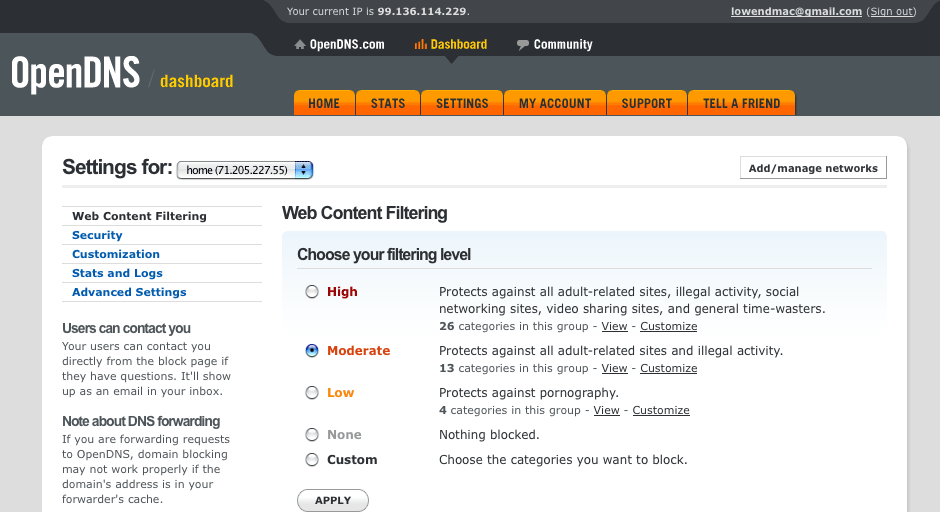
The OpenDNS dashboard lets you filter Internet content.
Publisher's note: We use OpenDNS on all of our Macs at Low End Mac
headquarters. Features include security against malware and phishing,
faster DNS lookups than most ISPs, and the ability to filter Internet
access as you see fit or using its preconfigured FamilyShield. All for
free. Recommended. dk
Link: Worried About Mac
Malware? Set Up Free OpenDNS
Link: OpenDNS
Free Test4Flashback Malware Checker
PR: Marc Zeedar, publisher of Real Studio Developer magazine,
has written a simple and free Test4Flashback utility that upon startup
tells you whether or not your Mac is infected. This software doesn't
attempt to do any removal.
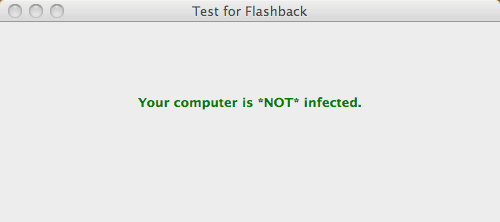
Link: Test4Flashback
Free FlashbackChecker Utility Detects If Your Mac
Is Infected with Flashback
PR: Juan Leon's free FlashbackChecker utility runs tests
described in the F-Secure Bulletin as of April 6th, 2012.
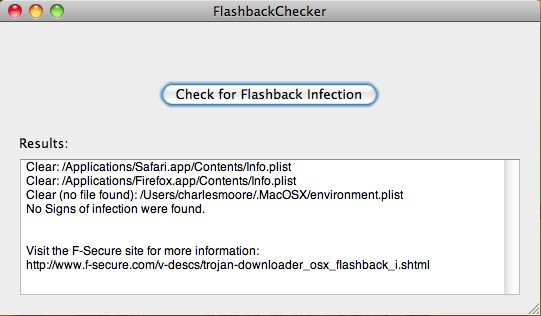
Note that this utility checks and reports the presence of Flashback
malware, but does not remove it, and Leon has no affiliation with
F-Secure.
Supported Mac OS versions:
- Mac OS X 10.5 up
- PPC and Intel
FlashbackChecker 1.0 is donationware.
Link: FlashbackChecker
F-Secure Issues Free Flashback Removal Tool
PR: F-Secure has released a free tool that automates
detection and removal of the Flashback Mac OS X malware. The tool
creates a log file on the user's Desktop, and if any Flashback
infections are found, they are quarantined into an encrypted ZIP file
(flashback_quarantine.zip) to the current user's Home folder. The ZIP
is encrypted with the password "infected".
F-Secure Corporation protects consumers and businesses against
computer viruses and other threats from the Internet and mobile
networks. F-Secure's award-winning solutions are available as a service
subscription through more than 170 Internet service providers and
mobile operator partners around the world, making F-Secure a global
leader in this market.
Link: Flashback
Removal Tool
Free Kaspersky Labs Tool Identifies and Disinfects
Flashback and Flashfake
PR: Kaspersky Labs experts recently analyzed the Flashfake
botnet and found a total of 670,000 infected computers worldwide, with
more than 98% of those computers most likely running Mac OS X. It
is anticipated that the other 2% of machines running the Flashfake bot
are very likely to be Macs as well. This is the largest Mac-based
infection to date, with the largest number of victims targeting
developed countries. The United States had the most infected computers
(300,917) followed by Canada (94,625), the United Kingdom (47,109) and
Australia (41,600). Other infected countries include France (7891),
Italy (6585), Mexico (5747), Spain (4304), Germany (4021) and Japan
(3864).
Users can check if they're infected with Flashfake by visiting
Kaspersky Labs' safe verification site, and can remove it using the
Kaspersky Flashfake Removal Tool.
On April 6 Kaspersky Labs researchers reverse-engineered the
Flashfake malware and registered several domain names which could be
used by criminals as a C&C server for managing the botnet. This
method enabled them to analyze the communications between infected
computers and the C&Cs. By connecting to Flashfake, Kaspersky Labs
experts are able to continuously monitor the botnet's communication
with active bots and have published their findings.
Throughout last weekend Kaspersky Lab experts saw a decline in the
number of active bots: on April 6 the total number was 650,748. At the
conclusion of April 8 the number of active bots was 237,103; however,
the decrease in infected bots does not mean the botnet is rapidly
shrinking. The statistics represent the number of active bots connected
to Flashfake during the past few days it is not the equivalent of the
exact number of infected machines. Infected computers that were
inactive during the weekend would not be communicating with Flashfake,
thus making them not appear as an infected bot.
Since connecting to the botnet for analysis, Kaspersky Labs'
sinkhole server has registered all the data sent by bots from the
infected computers and recorded their UUIDs in a dedicated database.
Based on this information, Kaspersky Labs experts have created an
online resource where all users of Mac OS X can check if their computer
has been infected by Flashback / Flashfake.
How to determine if your computer is infected:
- Visit Kaspersky Labs site at www.flashbackcheck.com to determine if
you're infected.
- This dedicated site is safe for users to visit and enter their
UUID, which will be checked in Kaspersky Labs Flashfake database of
infected computers. Instructions for entering user UUIDs are included
as well.
How to disinfect your computer:
If your UUID is found in the database, you need to disinfect your
Mac. Here are three recommendations to do this:
- Use a free special utility, the Kaspersky Flashfake Removal Tool.
It will automatically scan your system and remove Flashback if it is
detected. This is a free-to-download and free-to-use program.
- Download a trial version of Kaspersky Anti-Virus 2011 for Mac. This
program offers comprehensive protection against all known malicious
programs for Mac OS X, including Flashback.
- Detect and remove Flashback manually. Please follow the
instructions provided on the following page:
Link: flashbackcheck.com
Apple Developing Detection and Removal Software for
Flashback
Apple has released a statement regarding a recent version of
malicious software called Flashback that exploits a security flaw in
Java in order to install itself on Macs.
Apple released a Java update on April 3, 2012 that fixes the Java
security flaw for systems running OS X v10.7 and Mac OS X v10.6.
Apple also says it is is developing software that will detect and
remove the Flashback malware.
In addition to the Java vulnerability, the Flashback malware relies
on computer servers hosted by the malware authors to perform many of
its critical functions. Apple is working with ISPs worldwide to disable
this command and control network.
For Macs running Mac OS X v10.5 or earlier, for which no security
updates are offered, Apple suggests that you can protect yourself from
this malware by disabling Java in your web browser's preferences.
Publisher's note: Apple has received a black eye in the antivirus
community - firstly, because the security hole Flashback uses was
patched in February on Windows and Linux; secondly, because it took so
long to acknowledge the issue; and thirdly, because it attempted to
shut down some of the servers antivirus companies set up specifically
to monitor Flashback. Adding insult to injury, where (as noted above)
existing Mac antivirus apps have been updated to detect and remove
Flashback and some developers have created apps specifically to detect
the first widespread malware in the 11-year history of Mac OS X,
Apple has only promised detection and removal software at some
unspecified future date (see update immediately beow for
details on Apple's solution). Poor form, Apple. dk
Link: About Flashback
Malware
Apple Finally Deploys Mac Flashback Trojan
Terminator
The Register's John Leydan reports:
"Apple has released a tool that removes the infamous Flashback
Trojan from infected Macs.
"The utility, billed as a Java security update, also disables Java
applets by default - but only on machines running OS X Lion, the
latest version. The update turns off Java applet execution by default
for all browsers, not just Safari.
"Users can re-enable this if necessary, perhaps to use an online
banking site that mandates Java, but the functionality is disabled
again automatically in the absence of applet use within 35 days, as
Apple's security bulletin
for Lion explains:
This Java security update removes the most common
variants of the Flashback malware.
This update also configures the Java web plug-in to
disable the automatic execution of Java applets. Users may re-enable
automatic execution of Java applets using the Java Preferences
application.
If the Java web plug-in detects that no applets
have been run for an extended period of time it will again disable Java
applets.
Java for OS X Lion 2012-003 delivers Java SE 6
version 1.6.0_31 and supersedes all previous versions of Java for OS X
Lion.
This update is recommended for all Mac users with
Java installed
"The picture is different for Mac users running Snow Leopard, where
disabling Java in your browser won't happen automatically, as explained
in a blog post by Paul Ducklin of Sophos
here. The update for Snow Leopard does include Flashback Trojan
removal, as explained in Apple's bulletin here.
"Both the OS X Lion and Snow Leopard updates, released on Thursday,
come with a patched version of Java that was made available in a
separate set of updates earlier this week.
"Apple has made good on its promise earlier this week to release a
Flashback removal tool but the move came after several security firms
independently released their own Flashback detection and removal tools
(a list of free utilities is here).
"The Flashback Trojan created a zombie army of remote-controllable
650,000 Apple Macs, or more, by exploiting a Java security
vulnerability that Apple only patched last week, six weeks after a
patch for Windows machines became available.
"The Flashback Trojan has declined over recent days from a peak of
around 670,000 machines to around 270,000 bots (Symantec's latest
estimate) or lower. Despite the decline the zombie network remains an
undead menace."
Link: Apple Finally
Deploys Mac Flashback Trojan Terminator
Reinstalling OS X after a Malware Infection
MacFixIt's Topher Kessler says that while instructions are available
to remove the latest malware threats for OS X, some may choose to
simply reinstall OS X and start from a clean slate, although he
cautions that you may not be able to trust Time Machine or other data
backups or system clones to be free from the malware if you don't know
exactly when your Mac became infected, such as when you installed a
recent, now suspect update to Flash, then you might be able to
reinstall using backup from before the problem occurred.
However, there are ways to start again from a clean slate with
minimal data loss.
Link: Reinstalling OS X
after Malware Infection
News & Opinion
No Mac Pro Upgrade Makes Mac Power Users
Anxious
Hardmac's Lionel says that for reasons he has difficulty
understanding, while the Xeon E5 CPU is currently available from Intel,
Apple has not upgraded its Mac
Pro (last updated in July 2010), disappointing current Pro users
committed to Apple systems and applications who would like to get more
raw power to boost productivity.
Lionel thinks that Apple should indicate its intentions, as it did
it for Final Cut Pro X users, either by releasing/announcing the new
Mac Pro or communicating its plans for the Mac Pro's future - if it has
one - noting that many customers have been investing hardware and
software into Apple technologies for years, and they deserve to be
informed on this matter.
Publisher's note: The Mac Pro is the only current Mac that has not
yet been updated to include Apple's Thunderbolt technology, which is
aimed at high-end users - the Mac Pro's primary audience. At this point
the 27" 3.4 GHz quad-core i7-based
iMac, which has Thunderbolt but forces users to deal with a
monstrous 27" display they may not want, has more raw
processing power than the 3.33 GHz 4-core Mac Pro and nearly as
much as the 2.27 GHz 8-core Mac Pro. We understand the concern Mac Pro
user have that Apple is abandoning them, as Thunderbolt technology was
introduced to all other Macs in 2011. dk
Link: Lack of Mac Pro
Upgrade: Pro Users in Fear
Cowardly Lion: 11 Reasons Not to Upgrade to OS X
10.7 Lion
The Musings From Mars blogger says:
 "I am a big
admirer of Apple, Steve Jobs, and Mac OS X . . . [H]owever, as much as
I've tried to, I just don't like Mac OS X 10.7 ('Lion') certainly
not enough to upgrade to it from Snow Leopard. Unlike every previous
update to Apple's Unix-based operating system, there's really nothing
in Lion that's truly compelling or will make me more productive on my
Mac, and lot that isn't and won't....
"I am a big
admirer of Apple, Steve Jobs, and Mac OS X . . . [H]owever, as much as
I've tried to, I just don't like Mac OS X 10.7 ('Lion') certainly
not enough to upgrade to it from Snow Leopard. Unlike every previous
update to Apple's Unix-based operating system, there's really nothing
in Lion that's truly compelling or will make me more productive on my
Mac, and lot that isn't and won't....
"Perhaps some of Apple's vision for Lion will be better realized
when Mountain Lion (Mac OS X
10.8) is released this summer . . . but most of what I've
seen is filling in gaps with apps that are available on the iPad/iPhone
and don't have Mac equivalents (from Apple)...."
"...a brief list of the things I really don't like about Lion (in no
particular order):"
- Scrollbars
- Invisible User library
- Autosave
- Launchpad - Totally unnecessary a bit of screen fluff transported
from the iPod - "If Apple ever seriously considers replacing the Finder
with something like Launchpad, I definitely will not be moving with
them"
- Preserving Open Windows/Apps
- iCloud only being available only to users of Lion
- App Store that makes you pay up front for everything you download,
based solely on the developer's blurb and user ratings
- Full-screen apps - Arguably appropriate for some apps like
Photoshop, iPhoto, iMovie . . . it's just silly to tout this
a useful feature of the operating system. Can you imagine a full-screen
version of, say, Calculator?
- Finder feature changes
- QuickLook on Lion is different and inferior to that on Snow
Leopard.
- Toolbars - On Lion, Apple has removed the toolbar-toggle button at
the window's upper right-hand corner.
For full discussion of these points and more, check out the
blog.
Editor's note: This list of Lion shortcomings pretty much mirrors
mine and explains why I'm still using Snow Leopard. cm
Publisher's note: Apple has always been a forward-looking company,
dropping old technologies (such as floppy drives, SCSI, Classic Mode,
and Rosetta PowerPC emulation) when it deems them obsolete, and often
introducing new ones before the industry is ready to embrace them (for
instance, FireWire and Thunderbolt). This is in contrast to Microsoft,
which makes sure the current version of Windows works with lots of old,
old software and peripherals. To our benefit, Apple helps grow the
market for older Macs and Low End Mac every time is leaves an old
technology behind. dk
Link:
Too Tame to Tempt: Eleven Things That Keep Me from Upgrading to Lion
(Mac OS X 10.7)
OS X Lion Really Calls for an SSD
ZDNet's Robin Harris notes that Apple's adding iOS UI elements to OS
X means lots more small I/Os, the kind that hard disks do poorly and
SSDs do well, advising that you'll regret buying a new Mac without an
SSD - and speaking from experience.
Harris also notes that key aspects of OS X Lion performance - boot
up, file access times, page swapping, context switching - all suck
using even a 7200 rpm hard drive.
How much suckage? So much that Harris says a 1.86 GHz Core 2 Duo,
4 GB MacBook Air with a 128 GB SSD outperforms his 3.4 GHz
quad-core i7, 16 GB 2011
Thunderbolt iMac with a 1 TB SATA drive in performing 90% of
the work he does, and it is more stable as well.
Link: Mac OS Lion
Demands an SSD
Gartner: Macs Now #3 PC in US with 10.6% Share
Excluding Tablets
PR: Worldwide PC shipments totaled 89 million units in the
first quarter of 2012, a 1.9% increase from the first quarter of 2011,
when shipments reached 87.3 million units, according to preliminary
results by Gartner, Inc. These results exceed Gartner's earlier
projections of a 1.2% decline for the quarter.
"The results were mixed depending on the region, as we saw the EMEA
region perform better than expected with PC shipments growing 6.7% in
the first quarter of 2012, while Asia/Pacific performed below
expectations, in part because of slow growth in India and China," says
Mikako Kitagawa, principal analyst at Gartner. "While the PC industry
has high expectations for strong growth in the emerging markets, the
slowdown of these countries in this quarter provides a cautionary
notice to vendors that the future growth for the PC industry cannot
heavily depend on the emerging markets even though PC penetration in
these regions is low."
"In general, the hard-disk drive (HDD) supply shortage had a limited
impact on PC supply during 1Q12. There was a moderate impact on
selected markets, such as low-end consumer notebooks and the white-box
market in selected regions. Still, low PC demand was able to mask the
tight HDD supply overall."
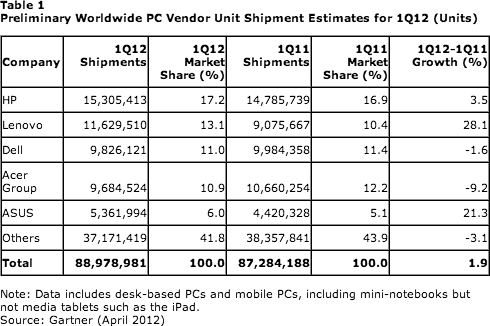
Although PC vendors typically experience low consumer PC sales in
the first quarter, Gartner's preliminary results reveal
worse-than-normal consumer PC shipment growth. The weak consumer PC
demand is in part because of intensified competition for consumers'
budgets. Device vendors that focus on a limited product line will get
only a small portion of the consumer wallet. Gartner notes that in such
a market environment, companies such as Apple can be clear winners
because of comprehensive product/service offerings, which gain a large
part of consumers' spending.
HP increased its share as the global market leader, as it accounted
for 17.2% of worldwide PC shipments in the first quarter of 2012 (see
Table 2). HP was able to secure HDD inventory, unlike 4Q11 when it was
faced with a shortage issue. HP's growth also indicates that internal
management issues were resolved, and analysts said it appears HP was
able to restore some of the business it lost as a result of those
issues.
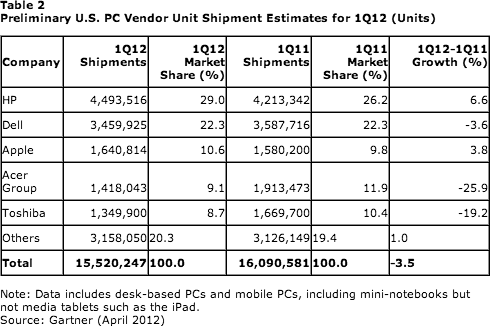
Lenovo experienced the strongest growth among the top five vendors,
as its shipments increased 28.1% in the first quarter of 2012. It
showed significant shipment growth in the EMEA market, with over 50%
year-over-year growth. Lenovo has been enjoying healthy growth in the
professional market, while the company successfully expanded into the
consumer space.
Dell underperformed in most regions compared with a year ago. For
the first time in two years, Dell experienced a year-over-year shipment
decline in the Asia/Pacific market. Gartner analysts said early
indications suggest that Dell's relatively low shipments were mainly
due to low-end consumer systems, to which Dell gave low priority.
Dell's investments seem to be more focused toward businesses.
In the US, PC shipments totaled 15.5 million units in the first
quarter of 2012, a 3.5% decline from the same period last year (see
Table 2). Gartner analysts had expected the market to decline 6.1% in
the quarter.
"The consumer segment continued to be a drag on market growth, as PC
demand was low," Ms. Kitagawa said. "The HDD supply shortage moderately
impacted the very low-end consumer notebook market, so channels could
not run aggressive promotions with very low-end systems. Questions
remain on whether low-end systems can attract consumers, as their
attention has moved to other devices."
HP experienced the strongest growth among the top five vendors in
the US, as its shipments grew 6.6%, and its market share reached 29% in
the quarter. Apple was the only other vendor among the top five to show
growth in the quarter, as its shipments increased 3.8%. Apple now
enjoys a 10.6% domestic PC market share, behind only HP (29%) and Dell
(22.3%)
PC shipments in EMEA totaled 28.2 million units in the first quarter
of 2012, a 6.7% increase from the same period last year. Professional
PC shipments were above expectations across most countries, but
consumer PC demand still varied greatly by country.
In Asia/Pacific, PC shipments reached 30.3 million units in the
first quarter of 2012, a 2% increase from the first quarter of 2011. In
China, shipments of desk-based PCs decreased significantly as there was
no longer a rural PC program in place to drive demand. In India, the
Tamil Nadu deal, operated by local government to provide free laptops
to students, was supposed to be executed in the first quarter, but it
has been postponed to subsequent quarters.
The PC market in Latin America declined 3.2% in the first quarter of
2012, as shipments totaled 9 million units. Mobile PC shipments grew
0.4% over the first quarter of 2011, while desk-based PC shipments
decreased 7.6%. Many white-box PC vendors had depleted inventory due to
the HDD shortage.
PC shipments in Japan grew 11.5% in the first quarter of 2012, as
shipments reached 4.4 million units. The double-digit growth was due in
part to the very weak performance in 1Q11, which was affected by the
earthquake and tsunami in Japan in March of last year.
"The first quarter of 2012 was a transitional period as the PC
industry is awaiting two big releases: Intel's Ivy Bridge and
Microsoft's Windows 8. Both are expected to be launched this year.
Although these new releases are not expected to stimulate demand as
much as the industry hopes, they will affect PC supply so that there
will be artificial supply control before and after the product
releases. There will be few products rolled out into the market until
these major releases have taken place," Ms. Kitagawa said.
These results are preliminary. Final statistics will be available
soon to clients of Gartner's PC Quarterly Statistics Worldwide by
Region program. This program offers a comprehensive and timely picture
of the worldwide PC market, allowing product planning, distribution,
marketing and sales organizations to keep abreast of key issues and
their future implications around the globe. Additional research can be
found on Gartner's Computing Hardware section on Gartner's website.
Link:
Market Share Alert: Preliminary PC Market Results, Worldwide,
1Q12
Rumor Roundup
Rumor: Apple to Release New iMacs in June or
July
AppleInsider Staff report:
"Apple's all-in-one desktop, the iMac, will receive an update with
Intel's next-generation Ivy Bridge CPUs in the June or July timeframe,
according to a new rumor."
Link: Apple to Release
New iMacs with Core i5, i7 CPUs in June or July
Apple Updates
Java for OS X Lion (2012-003) Update
Apple says Java for OS X Lion 2012-001 delivers improved
reliability, security, and compatibility for Java SE 6.
See https://support.apple.com/kb/HT5055
for more details about this update.
See https://support.apple.com/kb/HT1222
for information about the security content of this update.
File Size: 66.9 MB
System Requirements: OS X 10.7
Link: Java
for OS X Lion (2012-003) Update
Software
Gesture-based Sleipnir Browser Updated to Version
3.3.1
PR: The Sleipnir 3 Browser features:
Extremely simple design that doesn't need an address bar: URLs are
just a technical specification, and definitely not easy to use
information for people. We have removed the large address bar in
Sleipnir 3 to provide a vast space for visually displaying opened
tabs.

Extremely speedy gestures even with just one hand: You can operate
tabs at high speed as if magic by using the multitouch and mouse
supported gesture - [TouchPaging]. You do not need to do all your daily
browsing by clicking the small buttons on the screen because you can
perform gestures such as switching, going to previous, and closing tabs
with just one hand.
Sync bookmarks automatically: You can sync your bookmarks with
Sleipnir on other devices by using the free Fenrir Pass service.
Because synchronization of bookmarks are completed automatically, you
can use the same bookmarks as expected in any of your devices, whenever
you want.
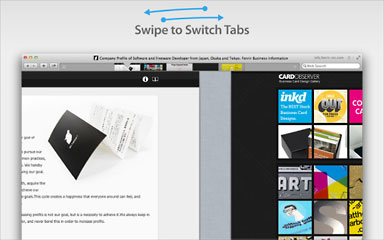
Other functions:
- Switch tabs by swiping tabs, left or right-click
- Operate tabs using a variety of gestures: Execute using touch
operations or while holding down the right-click button
- TiledTab: Pinch-in on the TrackPad to view a list of tabs
- Hold And Go: Hold down on a link to open in the background
- Ad Block
- Tab groups for managing tabs
- Sync bookmarks with other devices using Fenrir Pass
- The standard full-screen with OS X Lion
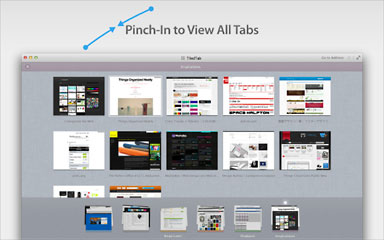
Sleipnir 3.3.1 changes include security strengthened by stricter
certificate displaying, "Unable to log into Twitter" issue fixed and
Bookmarks bar operations improved.
New in Version 3.3:
- Share pages (Twitter, Facebook, E-mail)
- Use multiple accounts for AutoFill Passwords
- Improvements to operations when downloading
- Bookmarks management method switched to Folders / Labels
- Manage cookies
- Export bookmarks
- German localization improved
- Italian language support added
- Swedish and Norwegian language support added
- Issue where some web pages could not be displayed properly
fixed
- Issue where Keychain checking frequently occurred in Mac OS X 10.6
Snow Leopard fixed
- Issue where the application would crash if tabs were moved to Tab
Groups in Mac OS X Snow Leopard fixed
- Performance improved
- Operational reliability improved
System requirements: Compatible with OS X 10.6 / 10.7
Sleipnir is freeware.
We have unfortunately had to remove some basic functions in the Mac
App Store version due to some restrictions by the Mac App Store. You
can also select the premium Black Edition that has no restrictions, and
includes special web creation tools.
Read Charles Moore's review of the Mac and iOS versions,
Sleipnir 3.3 Web Browser for OS X and Sleipnir Mobile for iOS
1.8.2, on MacPrices.
Link: Sleipnir Premium
Black Edition
Link:
Sleipnir on Mac App Store
TextWrangler 4.0: Free Text Editor Updated
PR: Bare Bones Software announced the release and immediate
availability of TextWrangler 4.0, a major upgrade to its high
performance, general purpose text editor for Mac OS X.
TextWrangler 4 adds new editing and disk browser window layouts,
switchable syntax color schemes, and seamless preservation of open
documents on relaunch.

In addition, TextWrangler 4 also includes a completely redesigned
Preferences window, a new Setup window, a streamlined filtering and
automation interface, new support for Verilog and VHDL, plus a new
modeless "Open File by Name" feature with efficient search-as-you-type
results as well as a slate of other significant performance and user
interface enhancements.
In TextWrangler 4, the new editing window now presents a streamlined
layout with easy, direct access to both open and recent documents. When
run on Mac OS X 10.7 (Lion), TextWrangler 4 also supports "Full-screen"
mode and "any edge" window resizing.
Upon quitting, TextWrangler 4 will now automatically remember the
contents of unsaved documents, and restore them the next time the
program is launched.
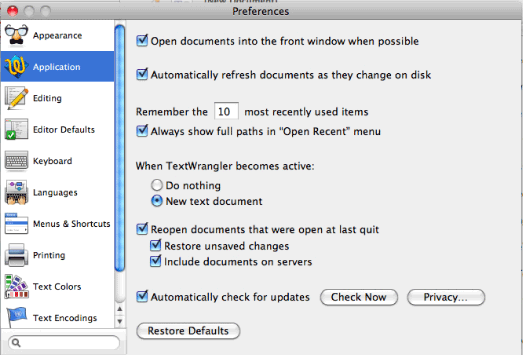
The new TextWrangler 4 Preferences window has been completely
re-imagined to make customization easier than ever. For example, a new
"Text Colors" preference panel now makes it easy to create and switch
between different color schemes. In addition, a new Setup window
provides a central location to manage configuration, including FTP/SFTP
bookmarks, grep patterns and file filters.
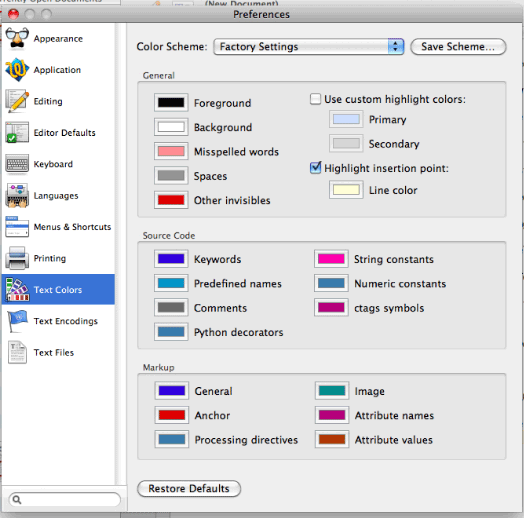
Access to text filters and scripts is now streamlined, plus
TextWrangler 4 now has the ability to treat AppleScripts, Automator
actions, and Unix scripts as co-equal and all may be used as text
filters or run directly as scripts.
System Requirements: TextWrangler 4 requires Mac OS X 10.6 or higher
(10.6.8, or 10.7.3 or later recommended).
All Mac OS X users may download TextWrangler 4 free of charge from
the Mac App Store or the Bare Bones Software download site.
Publisher's note: We've been huge fans of TextWrangler ever since
Bare Bones Software introduced it to replace BBEdit Lite, and after a
few days working with version 4.0, we're impressed. dk
Link: TextWrangler 4.0
(App
Store download)
Free MarsThemes Text Tools Utility
PR: Writers need ready access to a range of text functions in
whatever application one happens to be writing in.
In most of the rich text editors, those functions are available
somewhere in the app's menus, but typically located in different places
within each app, and some otherwise useful apps don't include one or
two key functions at all.
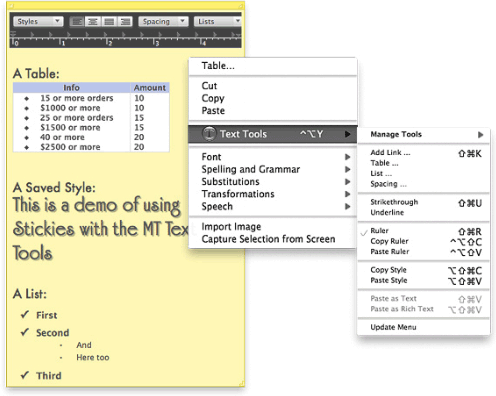
However Mac OS X has a rich text framework that provides a decent
set of editing tools, and it would be extremely handy to be able to
access that toolset consistently across apps, which is precisely what
the MarsThemes Text Tools app does: Grant easy access to the key OS X
Cocoa text tools that writers and editors need but often can't find
quickly or conveniently.
A example of this utility's usefulness is with Apple's Stickies app,
which apparently assumes that users only want to type paragraphs with
no formatting. Using the Text Tools, you can add The Ruler, a table,
and all the rest. Likewise for applications like Yojimbo and
TextWrangler, which provide no way to format text, but for which the
Text Tools let you add The Ruler, a table, etc.
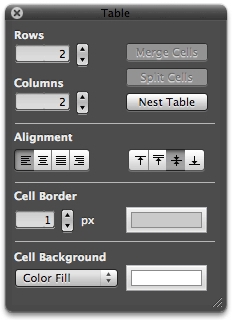 The
latest MarsThemes Text Tools version 1.1 release adds localizations for
13 languages plus English, and now filters out a multitude of console
messages that were set up during development.
The
latest MarsThemes Text Tools version 1.1 release adds localizations for
13 languages plus English, and now filters out a multitude of console
messages that were set up during development.
The key tools supported are:
- Tables
- Lists
- Links
- The Ruler
- Strikethrough
- Copy and Paste text styles
The MarsThemes Text Tools has two user options:
- Show more text tools
- Show Manage Tools menu at top.
Selecting the first option adds the following tools to the menu:
- Styles (used for adding a custom style to your personal list)
- A More Tools menu, which includes the Capitalize functions, which
normally appear in a submenu, as well as access to two handy formatting
tools to control inter-letter spacing and baseline setting.
- Access to the Substitutions setting panel.
- A link to open the handy Special Characters panel.
The Manage Tools menu also includes functions for checking updates,
uninstalling, and getting help.
The Text Tools application is programmed so that it only loads into
software that it detects has some kind of editing functionality, which
helps keep its overall footprint on your Mac as small as possible.
The Text Tools run as a plugin to the Mars Theme Loader (MTL)
framework. If you do not have MTL installed, the Text Tools installer
will do that for you. If you uninstall the Text Tools, the uninstaller
will disable the MTL agent at that time.
Text Tools is freeware.
Link:
MarsThemes Text Tools
iBackup Free Easy-To-Use Backup/Restore
Utility
PR: iBackup is a simple to use free utility that backs up and
restores user data and not only Mac OS system and applications settings
(e.g. System Preferences, Mail, iPhoto, iTunes) but also third-party
application settings. More than 250 plugins for backup application
settings are available, which allow you to restore the settings and
data of one application or to restore an earlier point in time.
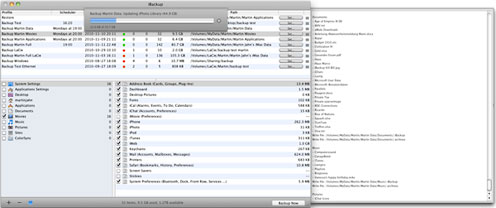
iBackup allows users to create profiles, each of which makes it
possible:
- to select the items to be backed up
- to specify scheduler information
- to manage backup folder settings
- to define connection settings
- to manage log file settings
- to manage UNIX copy commands settings
iBackup 2011 (7.4) supports Mac OS X 10.3.9, 10.4, 10.5, 10.6, 10.7,
and is ready for 10.8. It is free for personal use only. For commercial
purposes, licensing is available.
Link: iBackup
WaterRoof Free IPFW Firewall Front-end
PR: WaterRoof uses Mac OS X's built-in IPFW firewall. No
kernel modules, no extensions, no pain. WaterRoof is free and
open-source.
This advanced Mac OS X free graphic front-end for ipfw now features
a new, clean interface. WaterRoof lets you create, modify, delete, and
move ipfw ipv4 and ipv6 rules very quickly.
- Designed for Mac OS X and Mac OS X Server
- Build ipfw rules easily with the new simplified interface and the
IPFW Rules Translator. Building ipfw rules now is easier than ever
- Scan your Mac for running network services and filter open ports
with one mouse click
- List and ban remote hosts connected to your Mac
- Watch and parse firewall logs, create raw and graphic
statistics
- Look at active network connections, block them or limit their
bandwidth on-the-fly with the connection inspector
- List all processes that make or listen for network connections
- Backup and deploy firewall rules with WaterRoof Injectors
- Manage Network Address Translation (NAT) daemon: create a
dual-homed firewall/nat/router with port redirection and
forwarding;
- Manage rules on Mac OS X Server: WaterRoof is fully integrated with
Server Admin
- Manage NAT Port Forwarding (including Mac OS X Server 10.7
Lion)
- Configure a dual homed NAT firewall/router with Mac OS X Server
10.7 Lion: set up (*)working(*) port forwarding directives and choose
your favourite IP range for your LAN interface and clients
- Deploy firewall configuration using WaterRoof Injectors
- Import and export firewall configurations
- Quick DNS reverse and whois choosing from a list of whois
servers
- Manage network bandwidth with dummynet pipes
- Check live dynamic rules (IPFW States) created by stateful firewall
rules
- Import rules from NoobProof Injectors
- Keep your favourite firewall rules active at system boot
- Explore and test ipfw with configuration wizard and ready rule
sets
Tested on OS X 10.6.8 and 10.7.3 (client/server), runs on 10.8DP1
too.
New in version 3.6:
- New connection inspector
- Fully compatible with Mac OS X Server 10.7
- Added support for natd and port redirection on Mac OS X Server
10.7. See contextual helps for more info.
- New interface
- New boot script
- Added integration with serveradmin, now it is safe to use WaterRoof
on Mac OS X Server. Please see contextual helps inside the application
for more information.
- Fixed minor bugs
WaterRoof is free. PayPal donations accepted.
Link: WaterRoof
Desktop Mac
Deals
Low End Mac updates the following price trackers monthly:
For deals on current and discontinued 'Books, see our 13" MacBook and MacBook Pro,
MacBook Air, 13" MacBook Pro, 15" MacBook Pro, 17" MacBook Pro, 12" PowerBook G4, 15" PowerBook G4, 17" PowerBook G4, titanium PowerBook G4,
iBook G4, PowerBook G3, and iBook G3 deals.
We also track iPad,
iPhone, iPod touch, iPod classic, iPod nano, and iPod shuffle deals.




 "I am a big
admirer of Apple, Steve Jobs, and Mac OS X . . . [H]owever, as much as
I've tried to, I just don't like
"I am a big
admirer of Apple, Steve Jobs, and Mac OS X . . . [H]owever, as much as
I've tried to, I just don't like 








 The
latest MarsThemes Text Tools version 1.1 release adds localizations for
13 languages plus English, and now filters out a multitude of console
messages that were set up during development.
The
latest MarsThemes Text Tools version 1.1 release adds localizations for
13 languages plus English, and now filters out a multitude of console
messages that were set up during development.

